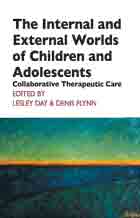The Internal and External Worlds of Children and Adolescents: Collaborative Therapeutic Care

Book Details
- Publisher : Routledge
- Published : 2003
- Cover : Paperback
- Pages : 200
- Category :
Child and Adolescent Studies - Catalogue No : 17365
- ISBN 13 : 9781855759282
- ISBN 10 : 1855759284
Customer Reviews
Our customers have given this title an average rating of 5 out of 5 from 2 review(s), add your own review for this title.
on 04/10/2004




 (5 out of 5)
(5 out of 5)
An extremely clear introduction by Lesley Day gives an overview of the work of the hospital with a summary of each chapter. This work is very helpfully set in the context of the provision (or rather lack of provision) of mental health services for children and adolescents and their parents in the NHS. The title of the book reflects the reality of these patients' less than favourable experiences and the life histories described make uncomfortable reading. The authors describe the way in which patients internalized their experiences, and how these unfolded during their stay in the hospital, in a setting which offered a structured and containing environment. More often than not, the patients' life experiences were re-enacted in the relationship to therapist and nurse as well as the wider community, and the book explores to what extent these experiences could be worked through and modified during the course of their treatment.
The majority of the papers are clinical accounts of treatment of the most disturbed and disturbing patients e.g. those with Munchausen syndrome by proxy, and borderline adolescents. The book offers a rich fare of clinical detail depicting the multifaceted work. It describes the stresses and strains of working with patients for whom the hospital is often the 'treatment of last resort', and how staff continue to engage with patients, which can feel like a depressing task in the face of the patient's own hopelessness, destructiveness, and provocation. The collaborative nature and coherence of the work is well illustrated in the first section, which documents the different aspects of working with families.
What comes across in every chapter is the care, not only for the patients' well being, but equally importantly the provision of support structures for staff, dealing as they do with primitive, destructive and perverse manifestation and behaviour. Such work can only be sustained in the setting of a therapeutic community and where 'an institution such as the Cassel becomes not a luxury but a basic prerequisite for such work to be carried out despite all its difficulties, shortcomings and cost.'
This book is about the care of some very disturbed individuals and families, care of a very special professional kind. Mental health workers will find much of interest to them in this book, and it should be compulsory reading for those who make policies about mental health provision. It is a book worth reading.
Lydia Tischler
Journal of Child Psychotherapy, Volume 30, No.2, August 2004
on 04/10/2004




 (5 out of 5)
(5 out of 5)
As one whose task it is to bring thinking about the needs of children and of whole families into an adult mental health service which is organizationally split off from the child and family services in its district, I read this volume of essays from the Cassel Hospital with interest and excitement at what can be achieved when the meaning of such splitting can be thought about, and with gratitude for the 'sense of hope (which) is held onto for the children and adolescents who are worked with at the Cassel' (p.12). The Cassel provides a unique service where adults, adolescents and whole families are admitted for psychoanalytic and psychosocial treatment and live as part of an in-patient therapeutic community in which patients share responsibility for their won treatment, for their children and for the daily management of the units.
The youngest patient worked with in this book is around one year old when she and her mother come into the Families Unit, while the Adolescent Unit works with young people who typically fall in the gap between adult and child mental health services, that is, aged from 16-21 years. Thus the book provides a developmental view with an emphasis on growth and transition, from child to adult, from the safe world of the hospital back to the community.
The book shows what can be done therapeutically in family situations where previously therapeutic work might have been unthinkable. The early part of the book describes first, adult psychotherapy with a mother who presented with Munchausen's syndrome by proxy, then, mother-infant psychotherapy with the same mother and her youngest, and finally individual child psychotherapy with two young children. Although these chapters all describe individual psychotherapies and are concerned primarily with the internal worlds of the patients, both adult and child, the emphasis is on the context in which such work takes place and is possible.
This important and hopeful book from Cassel gives us a close-up view of these processes operating in the internal world of patients, and how they can be acted out in the therapeutic community where there is the possibility of containment and understanding while external reality must still be faced. It demonstrates the organizational structures and thinking that are necessary if the developing child is to be kept in mind and is thus of relevance to all the mental health settings in which we work. There is a great deal in this slim volume which bears reading and re-reading.
Rosemary Loshak
Psychoanalytic Psychotherapy (June 2004) Volume 18, No. 2

